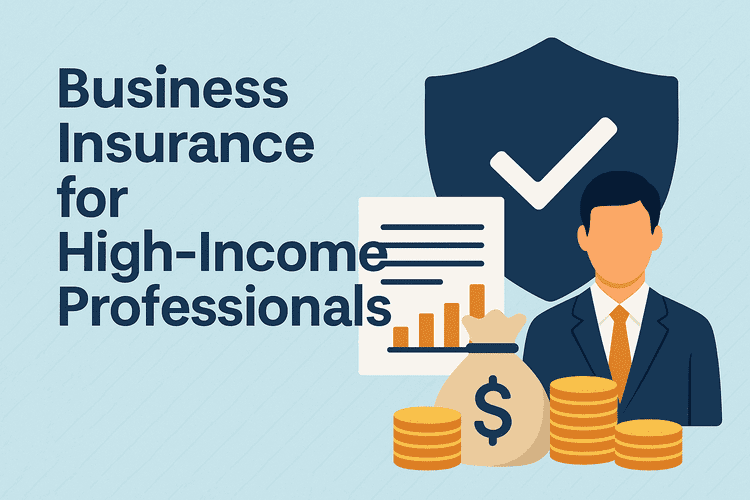The Overlooked Risks High-Income Professionals Face: Why Business Insurance Is Essential

High-income professionals often blur the lines between their personal and professional lives. But when it comes to insurance, that blur can lead to dangerous gaps in coverage—especially if you're relying on personal insurance policies to protect against business risks. This post explores real-world examples and outlines the essential business insurance policies every professional should consider.
Why Personal Insurance Isn’t Enough
Personal umbrella insurance follows the same exclusions as your underlying home or auto policies—meaning business activities aren't covered.
Real Example: The Attorney Who Paid the Price
An attorney in Buckhead occasionally worked from home. One day, a client visiting for a meeting slipped on the front steps and filed a lawsuit. The homeowner’s policy denied the claim due to its business activity exclusion, and the attorney had to personally cover the $175,000 settlement.
When Personal and Professional Lives Overlap
Common scenarios that create insurance blind spots include:
Using personal vehicles for professional purposes
Working from a home office
Offering professional advice informally
Serving on boards or committees
Employing household staff with dual roles
Real Example: Business Use of a Personal Vehicle
A physician in Atlanta was denied coverage after a car accident between practice locations. His personal auto policy excluded business use, highlighting the need for a business auto policy.
5 Business Insurance Policies High-Income Professionals Shouldn’t Ignore
1. Professional Liability Insurance (E&O / Malpractice)
Covers: Negligence, errors or omissions in professional services
Who needs it: Physicians, attorneys, consultants, financial advisors, real estate agents
Recommendations: $1–5 million in limits, claims-made vs. occurrence, tail coverage
Cost Range:
Physicians: $5,000–$50,000+
Attorneys: $1,500–$10,000+
Consultants: $1,000–$5,000
Real Example: A Duluth-based financial advisor faced a $1.2M claim. His $2M policy covered the settlement and $175K legal fees.
2. General Liability Insurance
Covers: Bodily injury, property damage not related to professional services
Who needs it: Professionals with physical offices or client meetings
Recommendations: $1M per occurrence / $2M aggregate
Common Inclusions: Premises liability, advertising injury
Cost Range: $500–$5,000+
Real Example: A client fell in a consultant's office. The $42,000 claim and legal defense were covered under general liability.
3. Business Property Insurance
Covers: Office contents, equipment, leasehold improvements
Who needs it: Anyone with office space or specialized equipment
Recommendations: Replacement cost valuation, business interruption coverage, cyber protection
Cost Range: $500–$7,500+
Real Example: A psychologist's office sustained $68,000 in damage and $22,000 in lost income after a burst pipe. Insurance saved the day.
4. Employment Practices Liability Insurance (EPLI)
Covers: Claims like discrimination, harassment, wrongful termination
Who needs it: Any professional with staff
Add-ons to Consider: Third-party discrimination coverage, wage and hour defense coverage, independent contractors
Cost Range: $800–$15,000+ depending on practice size
Real Example: A dental practice faced a $125,000 claim for age discrimination. EPLI paid the settlement and $47,000 defense costs.
5. Cyber Liability Insurance
Covers: Data breaches, ransomware, business interruption, fines
Who needs it: Anyone handling sensitive client data or accepting e-payments
Important Protections: HIPAA concerns, social engineering fraud, incident response services
Cost Range: $1,000–$20,000+
Real Example: A medical practice paid $45K ransom and covered $105K in recovery and lost revenue—thanks to cyber insurance.
How to Calculate Your Business Insurance Needs
Step 1: Assess Your Exposure
Factor in:
Business assets
Personal assets at risk (e.g., net worth excluding protected assets)
Future income potential
Step 2: Evaluate Your Risk Level
High Risk: Surgeons, trial attorneys, asset managers
Moderate Risk: General doctors, CPAs, engineers
Lower Risk: Consultants, agents, non-surgical professionals
Step 3: Review Your Business Structure
Understand the implications of structures like a Professional Corporation vs. an LLC.
Step 4: Coverage Recommendations
Professional Liability: $2–$5M for most, $5–10M+ for high-risk fields
General Liability: $1M–$2M minimum
Property: 100% replacement + 12–24 months business income
Cyber: $1M minimum, $2–5M for sensitive data
EPLI: $500K–$3M based on size
Common Business Insurance Mistakes
Mistake #1: Relying on Employer Coverage
Scenario: Moonlighting or consulting may not be covered
Fix: Get your own professional liability policy
Mistake #2: Ignoring Business in Social Settings
Even casual advice can trigger lawsuits. Make sure your coverage applies outside the office.
Mistake #3: Inadequate Business Interruption Insurance
Underestimating downtime is a common issue—ensure you’re covered for 12–24 months.
Mistake #4: Uncoordinated Policies
Personal and business coverage should be integrated to avoid gaps.
Mistake #5: Picking the Cheapest Policy
Beware of provisions like a hammer clause, which can limit your claim options.
5 Smart Ways to Save Without Sacrificing Coverage
Risk Management Programs
Get 5–15% off with training and proceduresHigher Deductibles
Save up to 25%—be sure you can absorb the costsBusiness Owner's Policy (BOP)
Combine coverages into one efficient policyProfessional Association Programs
Access group discounts via CPA, bar, or dental associationsMulti-Policy Discounts
Save 5–10% when bundling personal and business coverage
Concierge Insurance Group: Georgia's Professional Insurance Experts
We help professionals design comprehensive insurance programs through:
Risk assessments
Policy gap analysis
Personal + business integration
Access to top carriers
Claims support and advocacy
Ready for Peace of Mind?
Take the next step today:


